Simplicity Matters: Unraveling the Impact of Minimalist Packaging on Green Trust in Daily Consumer Goods
Abstract
1. Introduction
2. Hypotheses Development
2.1. Visual Attention and Green Trust under Packaging Complexity
2.2. Mediating Role of Manipulation Inference
2.3. Moderating Role of Expertise Level
3. Methodology
3.1. Experiment 1: Visual Attention and Green Trust under Different Complexity Packaging
3.1.1. Participants
3.1.2. Procedures
3.1.3. Results
3.1.4. Discussion
3.2. Experiment 2: The Mediating Role of Manipulation Inference
3.2.1. Participants
3.2.2. Procedures
3.2.3. Results
3.2.4. Discussion
3.3. Experiment 3: The Moderating Role of Expertise Level
3.3.1. Participants
3.3.2. Procedures
3.3.3. Results
3.3.4. Discussion
4. Conclusions and Implications
4.1. General Conclusions
4.2. Theoretical Contribution
4.3. Practical Significance
4.4. Limitations and Future Research Prospects
Author Contributions
Funding
Institutional Review Board Statement
Informed Consent Statement
Data Availability Statement
Conflicts of Interest
References
- Hannoura, A.P.; Cothren, G.M.; Khairy, W.M. The Development of a Sustainable Development Model Framework. Energy 2006, 31, 2269–2275. [Google Scholar] [CrossRef]
- Campbell, J.M.; Fairhurst, A.E. Reducing the Intention-to-Behaviour Gap for Locally Produced Foods Purchasing. Int. J. Retail Distrib. Manag. 2016, 44, 508–523. [Google Scholar] [CrossRef]
- Duong, C.D. Big Five Personality Traits and Green Consumption: Bridging the Attitude-Intention-Behavior Gap. Asia Pac. J. Mark. Logist. 2022, 34, 1123–1144. [Google Scholar] [CrossRef]
- Frank, P.; Brock, C. Bridging the Intention–Behavior Gap among Organic Grocery Customers: The Crucial Role of Point-of-Sale Information. Psychol. Mark. 2018, 35, 586–602. [Google Scholar] [CrossRef]
- Yamoah, F.A.; Acquaye, A. Unravelling the Attitude-Behaviour Gap Paradox for Sustainable Food Consumption: Insight from the UK Apple Market. J. Clean. Prod. 2019, 217, 172–184. [Google Scholar] [CrossRef]
- Chen, Y.-S.; Chang, C.-H. Greenwash and Green Trust: The Mediation Effects of Green Consumer Confusion and Green Perceived Risk. J. Bus. Ethics 2013, 114, 489–500. [Google Scholar] [CrossRef]
- Smith, N.; Leiserowitz, A. The Rise of Global Warming Skepticism: Exploring Affective Image Associations in the United States Over Time. Risk Anal. 2012, 32, 1021–1032. [Google Scholar] [CrossRef]
- van Doorn, J.; Risselada, H.; Verhoef, P.C. Does Sustainability Sell? The Impact of Sustainability Claims on the Success of National Brands’ New Product Introductions. J. Bus. Res. 2021, 137, 182–193. [Google Scholar] [CrossRef]
- Bloch, P.H. Seeking the Ideal Form: Product Design and Consumer Response. J. Mark. 1995, 59, 16–29. [Google Scholar] [CrossRef]
- Ilyuk, V.; Block, L. The Effects of Single-Serve Packaging on Consumption Closure and Judgments of Product Efficacy. J. Consum. Res. 2015, 42, 858–878. [Google Scholar] [CrossRef]
- Ansu-Mensah, P. Green Product Awareness Effect on Green Purchase Intentions of University Students’: An Emerging Market’s Perspective. Future Bus. J. 2021, 7, 48. [Google Scholar] [CrossRef]
- Pichierri, M.; Pino, G. Less Saturated, More Eco-Friendly: Color Saturation and Consumer Perception of Product Sustainability. Psychol. Mark. 2023, 40, 1830–1849. [Google Scholar] [CrossRef]
- Steenis, N.D.; van Herpen, E.; van der Lans, I.A.; Ligthart, T.N.; van Trijp, H.C.M. Consumer Response to Packaging Design: The Role of Packaging Materials and Graphics in Sustainability Perceptions and Product Evaluations. J. Clean. Prod. 2017, 162, 286–298. [Google Scholar] [CrossRef]
- Wang, Z.; Wen, Y.; Yan, N. Analysis of OTC Drug Packaging Design: A Model Based on The Role Separation of Consumers. In Proceedings of the 2020 2nd International Conference on Economic Management and Model Engineering (ICEMME), Chongqing, China, 20–22 November 2020; pp. 449–452. [Google Scholar]
- Granato, G.; Fischer, A.R.H.; van Trijp, H.C.M. A Meaningful Reminder on Sustainability: When Explicit and Implicit Packaging Cues Meet. J. Environ. Psychol. 2022, 79, 101724. [Google Scholar] [CrossRef]
- He, W.; Liu, C.; Lu, J.; Cao, J. Impacts of ISO 14001 Adoption on Firm Performance: Evidence from China. China Econ. Rev. 2015, 32, 43–56. [Google Scholar] [CrossRef]
- Mallon, B.; Redies, C.; Hayn-Leichsenring, G.U. Beauty in Abstract Paintings: Perceptual Contrast and Statistical Properties. Front. Hum. Neurosci. 2014, 8, 161. [Google Scholar] [CrossRef] [PubMed]
- Berlyne, D.E. The Influence of Complexity and Novelty in Visual Figures on Orienting Responses. J. Exp. Psychol. 1958, 55, 289–296. [Google Scholar] [CrossRef] [PubMed]
- Palmer, S.E. Vision Science: Photons to Phenomenology; Vision Science: Photons to Phenomenology; The MIT Press: Cambridge, MA, USA, 1999; pp. xxii, 810. ISBN 978-0-262-16183-1. [Google Scholar]
- Anderson, B.A.; Laurent, P.A.; Yantis, S. Value-Driven Attentional Capture. Proc. Natl. Acad. Sci. USA 2011, 108, 10367–10371. [Google Scholar] [CrossRef]
- Sun, Z.; Firestone, C. Curious Objects: How Visual Complexity Guides Attention and Engagement. Cogn. Sci. 2021, 45, e12933. [Google Scholar] [CrossRef]
- Jubert, R.; Dusinberre, D.; Radzinowicz, D. Typography and Graphic Design: From Antiquity to the Present; Flammarion: Paris, France, 2006; ISBN 978-2-08-030523-7. [Google Scholar]
- Jury, D. The Little Book of Typographic Ornament; Laurence King Publishing: London, UK, 2015; ISBN 978-1-78067-589-3. [Google Scholar]
- Favier, M.; Celhay, F.; Pantin-Sohier, G. Is Less More or a Bore? Package Design Simplicity and Brand Perception: An Application to Champagne. J. Retail. Consum. Serv. 2019, 46, 11–20. [Google Scholar] [CrossRef]
- Joye, Y.; Steg, L.; Ünal, A.B.; Pals, R. When Complex Is Easy on the Mind: Internal Repetition of Visual Information in Complex Objects Is a Source of Perceptual Fluency. J. Exp. Psychol. Hum. Percept. Perform. 2016, 42, 103–114. [Google Scholar] [CrossRef] [PubMed]
- Janiszewski, C.; Meyvis, T. Effects of Brand Logo Complexity, Repetition, and Spacing on Processing Fluency and Judgment. J. Consum. Res. 2001, 28, 18–32. [Google Scholar] [CrossRef]
- Unkelbach, C. Reversing the Truth Effect: Learning the Interpretation of Processing Fluency in Judgments of Truth. J. Exp. Psychol. Learn. Mem. Cogn. 2007, 33, 219–230. [Google Scholar] [CrossRef]
- Kirmani, A.; Zhu, R. Vigilant against Manipulation: The Effect of Regulatory Focus on the Use of Persuasion Knowledge. J. Mark. Res. 2007, 44, 688–701. [Google Scholar] [CrossRef]
- Loos, A. Ornament and Crime; Penguin Books Limited: London, UK, 2019; ISBN 978-0-14-139298-1. [Google Scholar]
- Vlachos, P.A.; Tsamakos, A.; Vrechopoulos, A.P.; Avramidis, P.K. Corporate Social Responsibility: Attributions, Loyalty, and the Mediating Role of Trust. J. Acad. Mark. Sci. 2009, 37, 170–180. [Google Scholar] [CrossRef]
- Sagarin, B.J.; Cialdini, R.B.; Rice, W.E.; Serna, S.B. Dispelling the Illusion of Invulnerability: The Motivations and Mechanisms of Resistance to Persuasion. J. Personal. Soc. Psychol. 2002, 83, 526–541. [Google Scholar] [CrossRef] [PubMed]
- Sujan, M. Consumer Knowledge: Effects on Evaluation Strategies Mediating Consumer Judgments. J. Consum. Res. 1985, 12, 31–46. [Google Scholar] [CrossRef]
- Lan, X.M. Why Does A Consumer Participate in the Co-Creation? A Study on Consumers’ Creative Motivation. Acta Psychol. Sin. 2007, 39, 343–354. [Google Scholar]
- Thompson, M.M.; Zanna, M.P. The Conflicted Individual: Personality-Based and Domain Specific Antecedents of Ambivalent Social Attitudes. J. Personal. 1995, 63, 259–288. [Google Scholar] [CrossRef]
- Campbell, M.C.; Kirmani, A. Consumers’ Use of Persuasion Knowledge: The Effects of Accessibility and Cognitive Capacity on Perceptions of an Influence Agent. J. Consum. Res. 2000, 27, 69–83. [Google Scholar] [CrossRef]
- Kritzer, H.M. The Professions Are Dead, Long Live the Professions: Legal Practice in a Postprofessional World. Law Soc. Rev. 1999, 33, 713–759. [Google Scholar] [CrossRef]
- Chen, Y.-S. The Drivers of Green Brand Equity: Green Brand Image, Green Satisfaction, and Green Trust. J. Bus. Ethics 2010, 93, 307–319. [Google Scholar] [CrossRef]
- Wang, Q.; Yang, S.; Liu, M.; Cao, Z.; Ma, Q. An Eye-Tracking Study of Website Complexity from Cognitive Load Perspective. Decis. Support Syst. 2014, 62, 1–10. [Google Scholar] [CrossRef]
- Aaker, J.L. Dimensions of Brand Personality. J. Mark. Res. 1997, 34, 347–356. [Google Scholar] [CrossRef]
- Baron, R.M.; Kenny, D.A. The Moderator-Mediator Variable Distinction in Social Psychological Research: Conceptual, Strategic, and Statistical Considerations. J. Pers. Soc. Psychol. 1986, 51, 1173–1182. [Google Scholar] [CrossRef] [PubMed]
- Orth, U.R.; Wirtz, J. Consumer Processing of Interior Service Environments: The Interplay Among Visual Complexity, Processing Fluency, and Attractiveness. J. Serv. Res. 2014, 17, 296–309. [Google Scholar] [CrossRef]
- Berlyne, D.E. Curiosity and Exploration. Science 1966, 153, 25–33. [Google Scholar] [CrossRef] [PubMed]
- Ettlinger, G. Conflict, Arousal, and Curiosity. Br. J. Psychiatry 1962, 108, 109–110. [Google Scholar]
- Kiwon Seo, J.P.D.; Shen, F. The Effects of Message Framing and Visual Image on Persuasion. Commun. Q. 2013, 61, 564–583. [Google Scholar] [CrossRef]
- Alba, J.W.; Hutchinson, J.W. Dimensions of Consumer Expertise. J. Consum. Res. 1987, 13, 411–454. [Google Scholar] [CrossRef]
- Czellar, S.; Luna, D. The Effect of Expertise on the Relation between Implicit and Explicit Attitude Measures: An Information Availability/Accessibility Perspective. J. Consum. Psychol. 2010, 20, 259–273. [Google Scholar] [CrossRef]
- Sinha, J.; Naykankuppam, D. Knowledge Does Not Necessarily Make the Heart Grow Fonder: The Moderating Role of Knowledge on Accessibility Experiences. J. Consum. Psychol. 2013, 23, 49–60. [Google Scholar] [CrossRef]
- Guy Assaker, P.O.; El-Haddad, R. Examining an Integrated Model of Green Image, Perceived Quality, Satisfaction, Trust, and Loyalty in Upscale Hotels. J. Hosp. Mark. Manag. 2020, 29, 934–955. [Google Scholar] [CrossRef]
- Pieters, R.; Wedel, M.; Batra, R. The Stopping Power of Advertising: Measures and Effects of Visual Complexity. J. Mark. 2010, 74, 48–60. [Google Scholar] [CrossRef]
- Kusumasondjaja, S.; Tjiptono, F. Endorsement and Visual Complexity in Food Advertising on Instagram. Internet Res. 2019, 29, 659–687. [Google Scholar] [CrossRef]
- Masuda, T.; Nisbett, R.E. Personality Processes and Individual Differences Attending Holistically Versus Analytically: Comparing the Context Sensitivity of Japanese and Americans. J. Personal. Soc. Psychol. 2001, 81, 922–9343. [Google Scholar] [CrossRef]
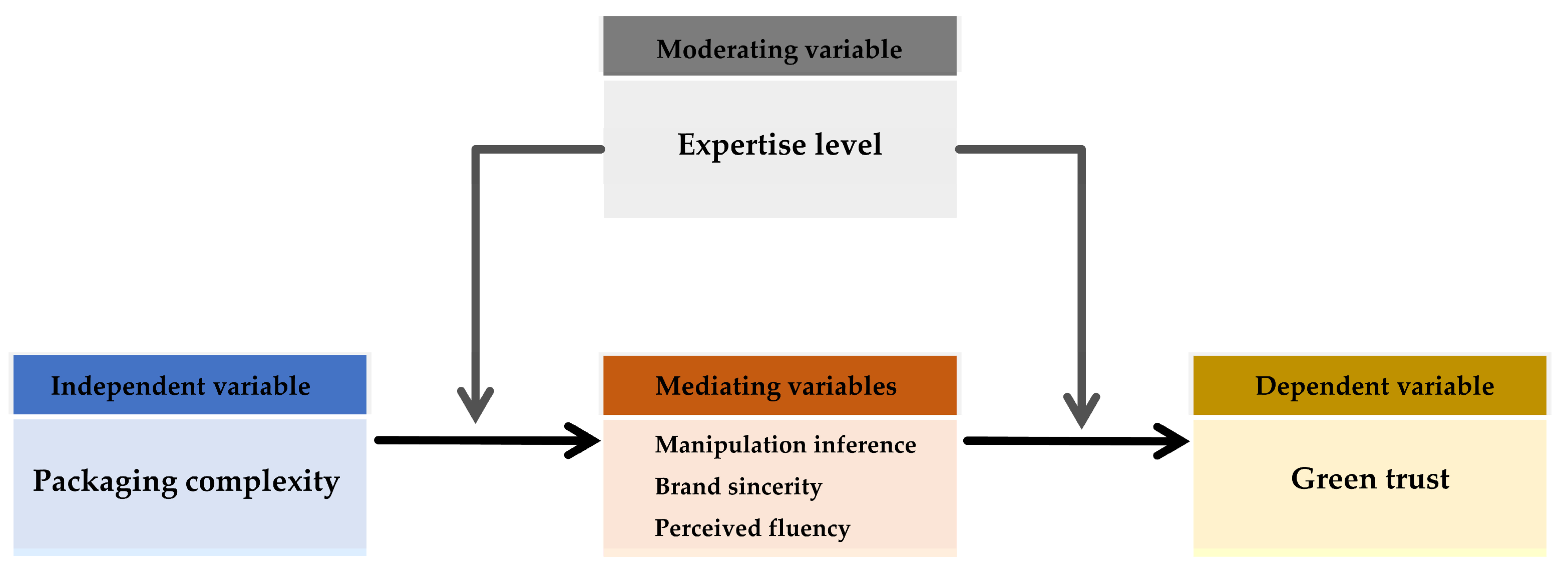
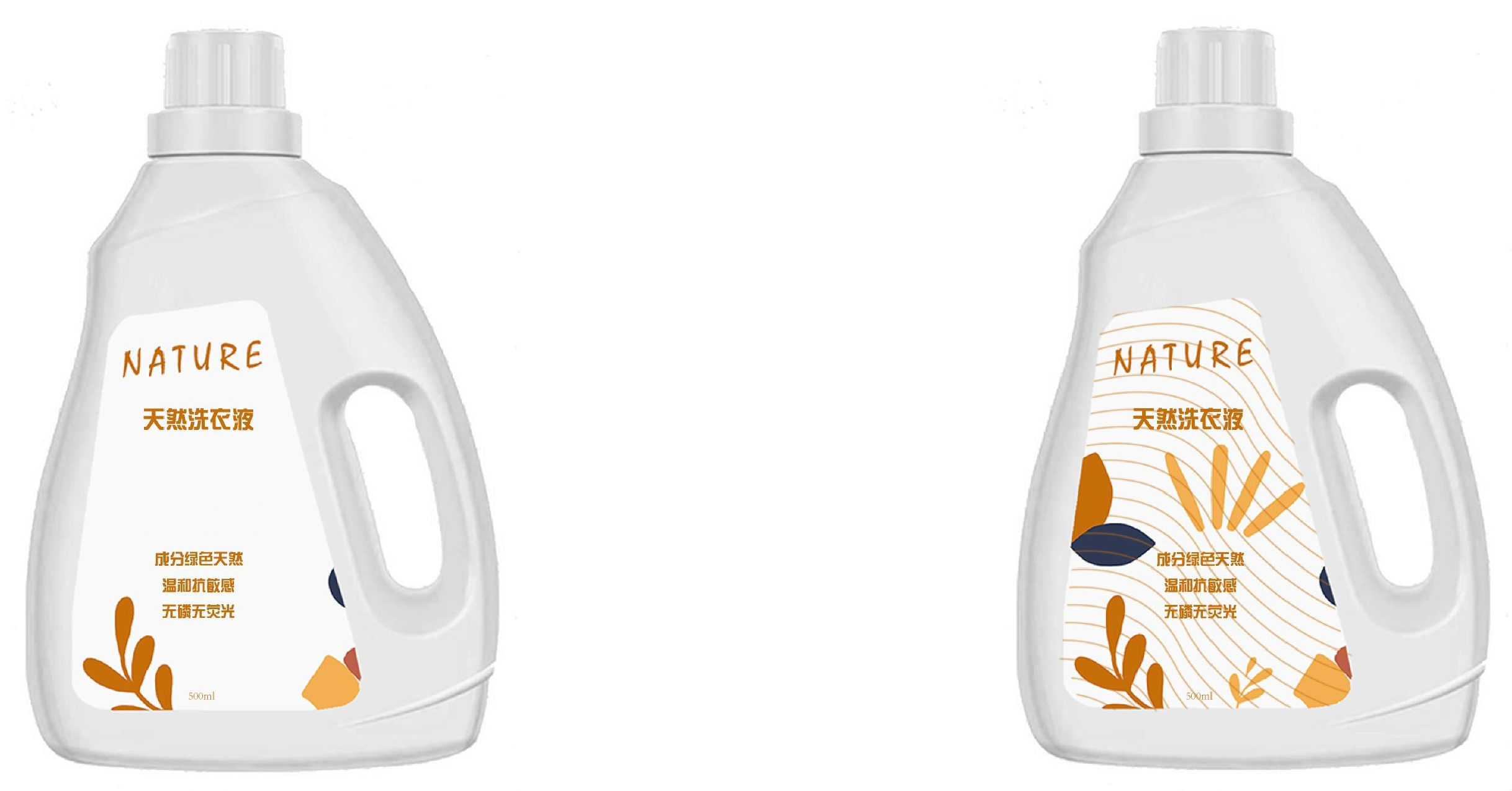
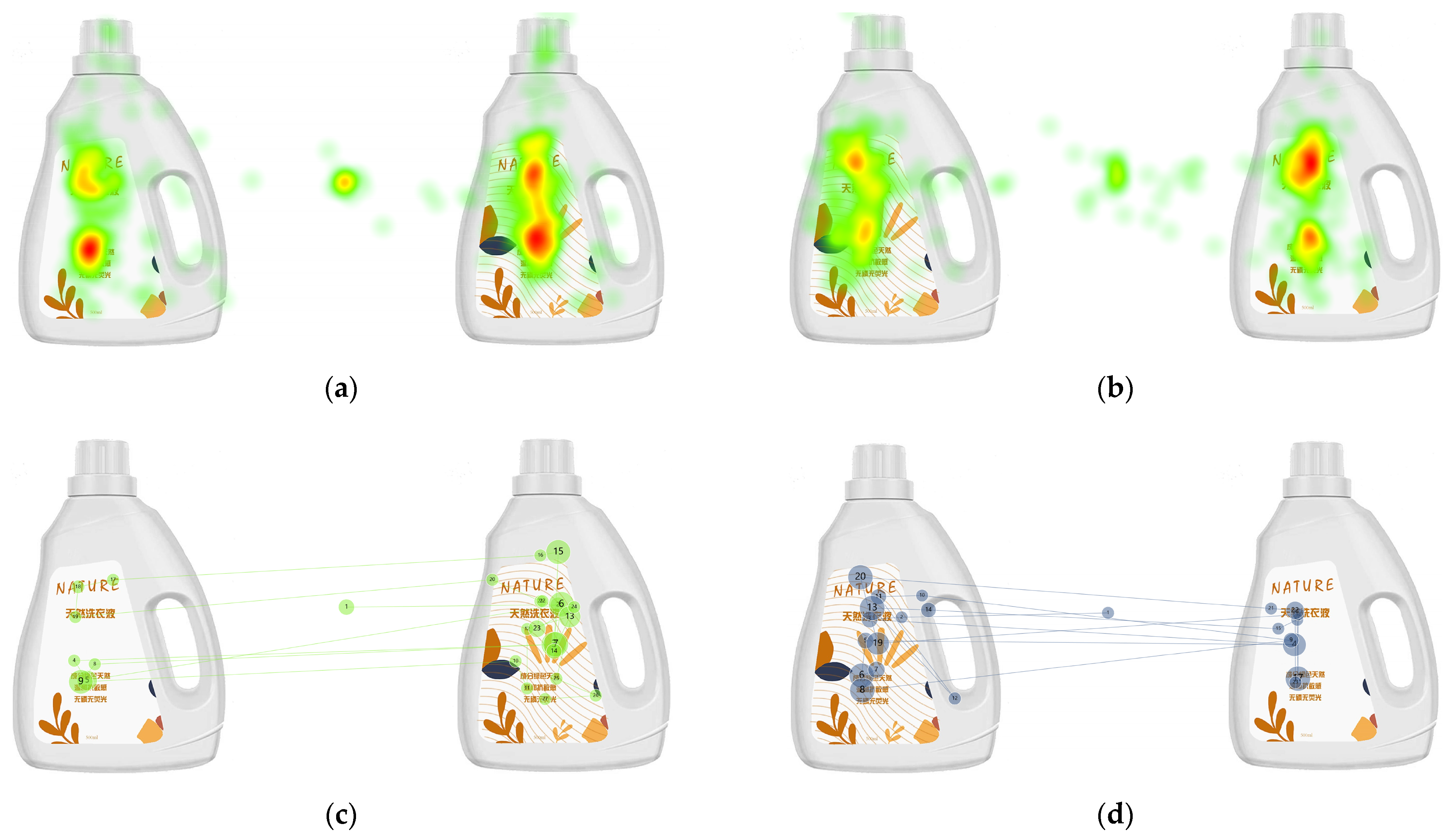
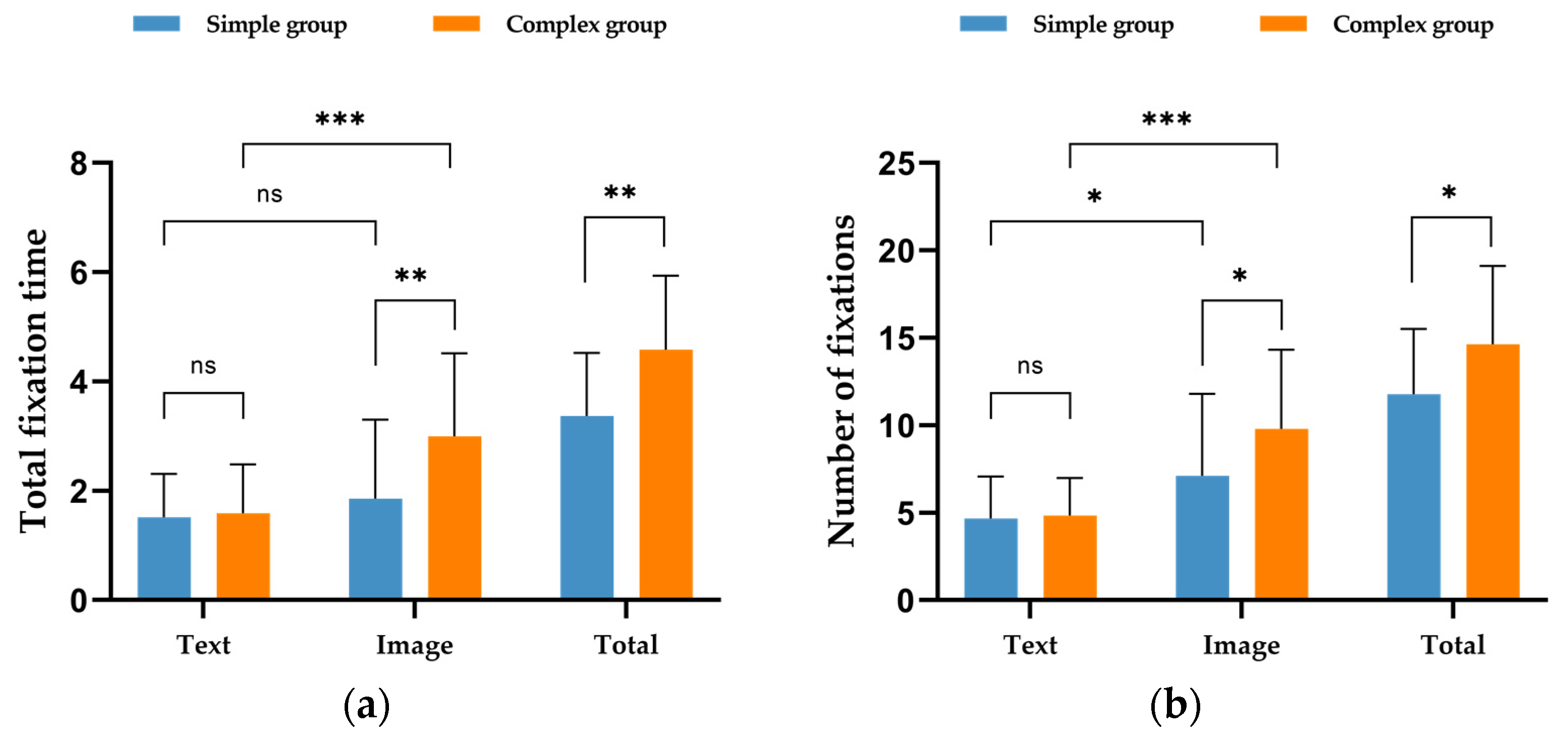
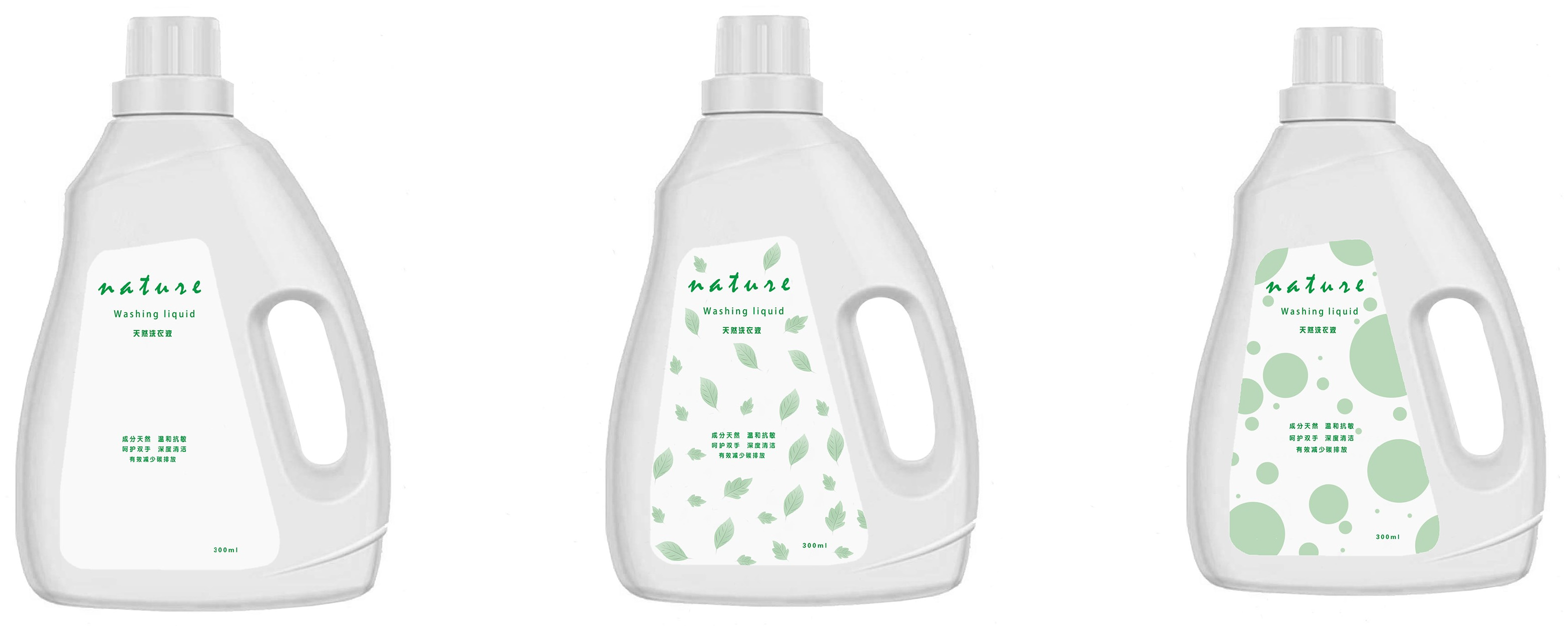
| Group | Simple Group | Complex Group | ||||
|---|---|---|---|---|---|---|
| AOI | Text area | Image area | Total area | Text area | Image area | Total area |
| Total fixation time | 1.517 | 1.856 | 3.373 | 1.589 | 2.997 | 4.586 |
| (0.794) | (1.448) | (1.153) | (0.892) | (1.519) | (1.354) | |
| Number of fixations | 4.667 | 7.111 | 11.778 | 4.833 | 9.806 | 14.639 |
| (2.414) | (4.701) | (3.727) | (2.158) | (4.515) | (4.467) | |
| Model 1 | Model 2 | Model 3 | |
|---|---|---|---|
| Variable | Green Trust | Manipulation Inference | Green Trust |
| Packaging complexity | 0.395 ** | −0.320 * | 0.214 * |
| (0.128) | (0.157) | (0.089) | |
| Manipulation inference | −0.566 *** | ||
| (0.087) | |||
| Intercept | 5.296 *** | 2.341 *** | 6.620 *** |
| (0.277) | (0.338) | (0.283) | |
| N | 202 | 202 | 202 |
| F | 4.153 | 1.998 | 16.31 |
| Model 1 | Model 2 | Model 3 | |
|---|---|---|---|
| Variable | Green Trust | Manipulation Inference | Green Trust |
| Packaging complexity | 0.496 *** | −0.393 ** | 0.362 *** |
| (0.085) | (0.13) | (0.081) | |
| Manipulation inference | −0.341 *** | ||
| (0.062) | |||
| Intercept | 5.295 *** | 2.453 *** | 6.132 *** |
| (0.236) | (0.299) | (0.229) | |
| N | 204 | 204 | 204 |
| F | 11.67 | 4.419 | 26.11 |
| Model 1 | Model 2 | Model 3 | Model 4 | Model 5 | |
|---|---|---|---|---|---|
| Variable | Green Trust | Manipulation Inference | Green Trust | Manipulation Inference | Green Trust |
| Packaging complexity | 0.535 *** | −0.599 *** | 0.198 | −0.600 *** | 0.136 |
| (0.138) | (0.156) | (0.102) | (0.163) | (0.095) | |
| Expertise level | 0.192 | 0.126 * | |||
| (0.124) | (0.052) | ||||
| Manipulation inference | −0.563 *** | −0.466 *** | |||
| (0.073) | (0.062) | ||||
| Packaging complexity × Expertise level | −0.371 * | ||||
| (0.148) | |||||
| Manipulation inference × Expertise level | −0.235 *** | ||||
| (0.055) | |||||
| Intercept | 5.691 *** | 2.878 *** | 7.312 *** | 1.971 * | 6.164 *** |
| (0.562) | (0.586) | (0.475) | (0.921) | (0.487) | |
| N | 200 | 200 | 200 | 200 | 200 |
| F | 5.018 | 5.585 | 18.36 | 4.787 | 28.95 |
Disclaimer/Publisher’s Note: The statements, opinions and data contained in all publications are solely those of the individual author(s) and contributor(s) and not of MDPI and/or the editor(s). MDPI and/or the editor(s) disclaim responsibility for any injury to people or property resulting from any ideas, methods, instructions or products referred to in the content. |
© 2024 by the authors. Licensee MDPI, Basel, Switzerland. This article is an open access article distributed under the terms and conditions of the Creative Commons Attribution (CC BY) license (https://creativecommons.org/licenses/by/4.0/).
Share and Cite
Ding, Y.; Meng, X.; Sun, C. Simplicity Matters: Unraveling the Impact of Minimalist Packaging on Green Trust in Daily Consumer Goods. Sustainability 2024, 16, 4932. https://doi.org/10.3390/su16124932
Ding Y, Meng X, Sun C. Simplicity Matters: Unraveling the Impact of Minimalist Packaging on Green Trust in Daily Consumer Goods. Sustainability. 2024; 16(12):4932. https://doi.org/10.3390/su16124932
Chicago/Turabian StyleDing, Yuechun, Xing Meng, and Cong Sun. 2024. "Simplicity Matters: Unraveling the Impact of Minimalist Packaging on Green Trust in Daily Consumer Goods" Sustainability 16, no. 12: 4932. https://doi.org/10.3390/su16124932
APA StyleDing, Y., Meng, X., & Sun, C. (2024). Simplicity Matters: Unraveling the Impact of Minimalist Packaging on Green Trust in Daily Consumer Goods. Sustainability, 16(12), 4932. https://doi.org/10.3390/su16124932







